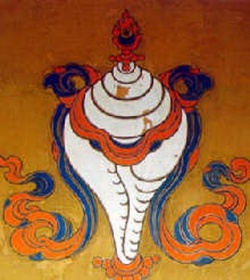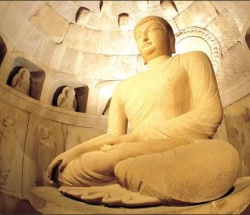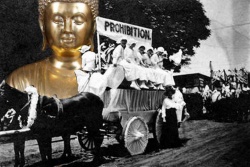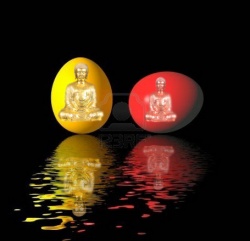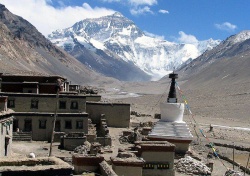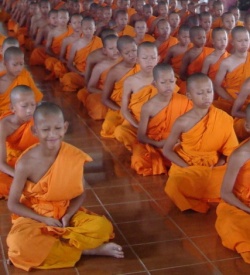Sakya Pandita - Glimpses of His Three Major Works by the late Khenpo Migmar Tsering (Abbot of Sakya College from May 1989 - February 1999)
The importance of Sakya Pandita as an author is well indicated by the fact that his works were most commented upon or quoted by the subsequent scholars. By this reckoning Sakya Pandita was clearly one of the most influential writers in the history of Tibetan scholarship. What to talk of the bulk of commentaries written by his own followers Sakya Pandita's treatise also inspired - or provoke - a number of words by leading luminaries of other traditions. Being the undisputed pioneer of introducing the complete ten fields of knowledge in Tibet, it is not surprising that his writing covered almost all the sciences. Here I will attempt to present before you some on the principle and profound ideas expounded in three of his major works viz.,
1) Elucidating the Sage's Thought
2) Pramanayuktinidhi
3) Trisamvaraprabedha.
1) Elucidating the Sage's Thought
This treatise (Sanskrit; Munimataprakasha) is related with both Prajnaparamita and Madhyamika and also establishes the conformity of the views of Arya Nagarjuna and Maitreyanath, the two expounders of the explicit and implicit meanings of the Prajnaparamita sutras. This is in fact a commentary of a passage of two key verses from the 20th Chapter of Attributes in the Mahayanasutralankara. He finds in it a complete set of the theory and practice of the Mahayana path and explains it through seven subjects - matters viz.
1) Spiritual lineage (gotra),
2) Refuge,
3) Bodhicitta,
4) Six paramitas
5) Four means of gathering disciples
6) Spiritual path and ground and
7) The state of Buddhahood.
When describing the common and uncommon qualities of the Buddha at the end of the text he writes 13 historical verses as an appendix to the 17 verses already existent in the last chapter of Sutralanakara. Thus the Buddha is praised through 30 divisions of his uncontaminated qualities.
Two truths
The topic of the two truths is one of the most talked about in all the philosophical works. Sakya Pandita also dealed with this theme separately in this as well as other works. Needless to say, all the philosophical points are raised and discussed on the basis of these two truths. Hence, a little penetration into this subject seems appropriate. After collecting information from various pieces of his writings on this matter the following conclusions can be ascertained as his opinions, as arranged and explained very lucidly and precisely by the great influential Sakya scholar Gorampa Sonam Senge (1429-1489) whose views are considered definitive and whose writings are the central pillar of modern Sakya scholarship.
Firstly, the definition of two truths are accepted as presented in the Madhyamikavatara where it is said; - "the object of correct seeing is in the ultimate truth, and that of false seeing is the conventional truth".
Correct seeing refers to Arya's meditative equipoise (samahita) and false seeing refers to the cognition deluded by the ignorance of true grasping. A common being's examining knowledge is not exactly a correct seeing but due to its rejection of true existence it is subsumed in it. Likewise, the subsequent attainments (pristalabdha) of the lower Arya's are not exactly false seeing but because their mode of grasping is conventional they are subsumed in it. Thus, all the objects and congnising subjects appearing as dual are the conventional truth or the deceptive truth and the ultimate truth is the state of being free from all the conceptual elaborations (prapancha), which is to be experienced by the Arya's meditative equipoise through cessation of duality. In the 9th Chapter of Wisdom in the Bodhicaryavatara it is said; - "ultimate truth is not an object experienced by the mind. Mind is to be understood as the conventional truth."
This does not show the definition (lakshana) but the basis of definitions (lakshana - adhistan) of the two truths. Consequently, Chandrakirti and Shantideva are found harmonious in identifying the two truths.
In support of the fact that the state of being free from all the extremes and graspings is the ultimate such-ness Sakya Pandita quotes several Sutras, such as Samadhirajasutra and Kashyapapariprcchasutra and, of course, Nagarjuna's Shastras. They are all in agreement in condemning the viewing of solitary emptiness. It should be noted here that the term "emptiness" stands for two different meanings depending on the way it is used. One is the emptiness being free from the first extreme alone, i.e. the extreme of existence, and the other is the ultimate emptiness of being free from all the extremes. The target of attacks in the Sutras and Shastras on the viewing of emptiness is obviously the grasping of the first emptiness. It is due to this reason that the Buddha and Nagarjuna frequently cautioned their followers against going for the wrong emptiness. In Samadhirajasutra even an exemplary account is given of a certain practitioner who, after remaining in the mediation of emptiness for 12 long years has finally to be satisfied to be reborn as a cat. Nagarjuna, in turn, warns; - "If emptiness is viewed wrongly, those of inferior intellect are ruined like wrongly holding a snake, or wrongly using a spell."
However, the two truths that the scholars show through words, listen to and contemplate have to be established on the different basis from the above for the existence of such truths depends solely on the worldly thought. To the Arya's meditative equipoise they both remain the conventional truth. This set of two truths is the one mentioned by Nagarjuna in Mulamadhyamika-karikanama when he says;- "the teachings that the Buddhas preach, are based on the two truths."
To put it briefly the ultimate truth mentioned in this and the ultimate truth defined by Chandrakirti do not share a common definition.
Some scholars believe the Madhyamika does not accept any doctrine of its own because a Madhyamika means an Arya and the Madhyama refers to the Arya's meditative equipoise where all the conceptual elaborations have been pacified. In other words, the system of the two truths is constructed only on basis of the worldly conception. Some others exert that according to the Prasangika Madhyamika even in the conventional truth the theory of being neither existent nor non-existent has to be applied with all the phenomena. On the other hand, another school says that this theory is inapplicable not only in the conventional truth but in the ultimate truth too. All these viewpoints are rejected here. Instead, it is confidentially affirmed that every phenomenon is neither existent, non-existent, nor both nor non-both in the ultimate truth. Refutation of inherent existence or true existence alone is never enough and complete.
Concerning the issue of whether these two truths are one or separate Sakya Pandita writes that they are separate but not in the sense of separate entities of characteristics. This is particular type of separate termed as the separate of the elimination of oneness, as in the case of entity and non-entity. The faults mentioned in Samdhinirmochanasutra (Sutra Unraveling the Thoughts) for considering the two truths as either one or separate meant for such notions in the ultimate truth. Therefore, the conviction that the two truths are the same characteristic/ substance but separate negatives/opposites (vyavrittita-binna) is highly refutable.
Refuting the Validation of Phenomena
In connection with the conventional truth what others call as the valid establishment of phenomena is not accepted here. Phenomena are valid only as far as the conventional worldly cognitions are concerned. In the Arya's meditative or an analyzer's examining knowledge no phenomenon is perceived as validly established, may it be an imputed or an imputing factor or a basis of imputation. Even after examining of the suchness of all the phenomena if something valid was still left it would naturally become inherently existent. In the ultimate truth there does not exist any phenomenon whatsoever other than what is realized by the Arya's transcendental wisdom. Sakya Pandita's followers do not agree on the idea that the nominal phenomena never became inexistent despite the fact that the Arya's non-conceptual wisdom does not perceive them. To believe thus is like accepting in the worldly ultimate the existence of a mirage, hairs in the space etc. even after an undiluted eye-consciousness has not observed them.
Some scholars lament that if the validation of phenomena were not be taken into account we would be unable to explain the different functions of the individual phenomena, e.g. the difference in the fact that fire burns and the water does not. Moreover, we would not be able to establish the law of cause and effect. However, such worry is found inadmissible here. Sakya Pandita directly follows the statements of Chandrakirti and others that all the phenomena (including their distinct functions) exist only for the world without analysis. If objects are sought through analysis among or separate from their bases of imputation they cannot be found at all.
Likewise, the relationship between an action (karma) and its effect is also well established only in the conventional truth without pursuing an ultimate analysis. The cause, i.e. karma, neither remains nor ceases inherently until the fruition of its effect. Therefore, the need does not arise here to seek the help of a medium between the cause and effect such as the other schools do and put forward things like "unwasted substance" (avipranashadravya), "the acquisition" (prapti), the continuum of mental consciousness, the continuum of "mind-basis-of-all" (alayavijnana) and the "disintegrated entity" (Tibetan; zhig.pa.dngos.po)
According to Sakya Pandita and his followers alayavijnana is not thoroughly rejected by Chandrakirti in the Madhyamikavatara. What he actually refutes is an inherently existent alayavijnana as asserted by Chittamatrins. A conventional alayavijnana is accepted by the madhyamika's too. In fact, Nagarjuna explicitly expresses his acceptance of alayavijnana in his work, Bodhicittavivarana. In Trisamvaraprabedha Sakya Pandita clearly accepts 8 consciousnesses - the afflicted mind (klishtamanas) and alayavijnana being the two extras upon the general six. Being Mahayanist the Prasangika Madhyamikas have to accept not only the 8 consciousnesses but also the three natures - parikalpita, paratantra and parinishpanna. This is harmony with a passage from the Lankavatarasutra which runs;- "the five dharmas and the three natures, the eight consciousnesses and two selflessnesses in these are subsumed all the Mahayana principles."
The self-consciousness (svasamvedana) is also acceptable to the Prasangika Madhyamika in the conventional truth. The self-consciousness refuted in the Madhyamikavatara and other texts is obviously the inherently existent one asserted by Chittamatrins with the support of an inherently existent memory.
Lastly, Sakya Pandita's works do not differentiate the Svatantrika Madhyamika's ultimate view of emptiness from that of the Prasangika. Their differences lie only in the interpretations of certain conventional points and in the mode of ascertaining the ultimate emptiness.
2) Pramanayuktinidhi
Pramanayuktinidhi (mine of logic-reasoning) is an important milestone in the development of study of logic-epistemology in Tibet. It actually consists of two separate but intimately related works; a mula composed mnemonic verses and the author's own prose commentary. He first studies Pramanavinishcaya under the Tibetan scholar Tseg-ton Wangchuk Sengge since the teaching lineage of Pramanavartika was almost already extinct by then. It was later from Kashmiri Pandita Shakyasribadra and some other Pandits of Nepal and Eastern India that he was able to study Pramanavartika and many other logic root texts and commentaries. When Shakyasribadra was first teaching Dharmottara's commentary to Pramanavinishcaya Sakya Pandita, who was by then very well versed in Sanskrit spread his Tibetan versions of the text and listened to the explanations. Afterwards, he surprised his Kashmiri teacher and the entourage by repeating the contents of the texts in Sanskrit.
At that time he is said to have asked his foreign teacher whether he accepted a "nere blue" which is opposite from "non-blue". Such near things or generalities (samanya) were believed to be substantially existent by the then Tibetan logicians. Shakyasribadra said in reply that he did not know of any "near things" but "blue" did exist in actuality. By this he gained an understanding of all the difficult points of exclusion (apoha). Subsequently he wrote Pramanayuktinidhi with the air of establishing the two traditions of Dignaga's Pramanasamuccaya and Dharmakirti's Seven Logic Treatise and correcting a number of fallacies and misinterpretations by previous Tibetan scholars. This logic text is believed to have been translated into Sanskrit by the disciples who accompanied Shakyasribadra. Moreover, he continued to teach Pramanavartika to his disciples until the age of 63. Thanks to his kind efforts that the teaching system of Pramanavartika has remained as bright as the sun till our time.
Eleven Chapters
Sakya Pandita has his work divided into 11 chapters. In the first chapter he discusses the divisions of objects and their separate identities. He refutes the assertions of Dharmottara and his followers that the graspable object (grahaya vishaya) and the appearing object (pratimasa bishaya) are synonymous and the penetrant object (adhyavasaya vishaya) and referent object (pravritti vishaya) are synonymous. He clarifies that the individual characteristic (svalakshana) itself becomes the three objects - appearing object, referent object and penetrant object - depending on the type of subjective cognition that looks at it.
In the second chapter he refutes the five types of non-valid consciousnesses mentioned by the early Tibetan logicians and approves of only three. The two excluded are "correct assumptions" (Tibetan yid dpyod) and "appearing but not ascertained (Tibetan snang la ma ngs pa.) he argues that if correct assumption is produced as a result of a correct proof it becomes an inferential valid cogniser (anumanapramana). If not, it falls under the category of non-cognising consciousness. The consciousness of appearing but not ascertained" is never a non-valid cognition. It is, in fact, a direct valid cognition (pratyaksha-pramana) a direct valid cogniser is non-conceptual and therefore need not ascertain anything.
In the third chapter he refutes the relationship of generality (samanya) and entity approved by the then scholars. He bases his opinion on the 8 reasonings for establishing the non-entity of generality described in Pramanavartika's third chapter of Pratyaksha.
In the fourth chapter he deals with the subject of exclusion (apoha) those who place the exclusion in the individual characteristic are proved wrong and, instead, he establishes the exclusion in the conceptual mind's way of functioning.
In the fifth chapter he examines the performance of the words and finds that the words also function through exclusion like the conceptual mind. In the sixth and seventh chapters he describes the varieties of causality (sambandtha) and contradiction (virodha) and makes it clear that these are possible only on the basis of sensible facts but not in the sphere of the absolute. The eighth chapter is devoted the explanation of the definition, the defined (lakshya) and the basis of definition. Here, he also opposes Devendrabuddhi, Prajnakarajupta, Dharmottara, Shankarananda, and their followers for their presentation of the two definitions of pramana as separate.
In the ninth chapter he talks on the various aspects of Pratyaksha and in the tenth chapter on the divisions of the correct and false statements of proof or syllogism (pararthanumana). Finally in the eleventh chapter he sets forth the divisions of person engaged in debate and the classification of defeats (nigrasthana).
3) Trisambvaraprabedha
None of Sakya Pandita's works has inspired so many commentaries and provoked so much controversy as the Trisambvaraprabedha (Differentiation of the Three Vows). This work is a classic statement of the need to subject religion to rigorous examination for the sake of removing anything spurious and establishing that which is authentic. The work sets out to treat three principle topics that are the three systems of religious vows - Pratimoksha, Bodhisattva and Guyhamantra - and their interrelations.
Pratimoksha is divided into Shravaka, and Mahayana Pratimoksha. Here, Sakya Pandita quotes form the Abhidharmakosha to present the views of the Vaibashikas who believe that the vows, particularly the Pratimoksha, are material substance which includes both the revelatory and non-revelatory forms (avijnapati-rupa) because they are born from actions of body and speech. Being material in nature they are lost death. Following the Mahayana tradition Sakya Pandita personally regards all the vows as mental factors in nature. Some commentator assert that even in the Mahayana system all the Pratimoksha vows are necessarily forms because a person received his Pratimoksha vows in accordance with the ceremony prescribed by the Shravaka schools. This argument in found unreasonable. If one were to follow this reasoning one would have to agree that the Bodhisattva vow received through the ceremony of Chittamantra system is inherently existent, for this is what the Chittamatrans believe. Whatever varying notions the different schools may express only one view among them has to be authentic and has to correspond with reality. Besides, the Mahayanist, in the first place do not approve of a non-revelatory form (avijnapati-rupa) at any time. In comparison to the Shravaka Pratimoksha, the Mahayana Pratimoksha is defined as the ordinary Pratimoksha plus the Bodhicitta.
Unlike the Pratimoksha the Bodhisattva vow being born from mind, continues into the next rebirth due to the force of one's resolve which is it's prerequisites and persists as long as the thought that bears it does not fail. The Bodhisattva vows hold the Pratimoksha vow but allows it to be superseded, when conditions are appropriate, by the necessity to help others. Sakya Pandita further distinguishes the Pratimoksha of the Shravaka from that of the Bodhisattva in terms of karma and effect. There are many instances when a certain karma is virtuous for the Shravaka but is sinful for the Bodhisattva and vice versa. If a Bodhisattva should generate the aspiration of the Shravaka, then even if he has practices for many ages, it is grave Bodhisattva infraction. But when he has the benefit of others in mind even the four Bhikshu defeats (parajika) turn out to be wholesome and virtuous.
Some said that love, compassion and the like are wholesome by nature. This is not the definitive judgement. For the unwise, love and compassion may be the cause for a lower rebirth. Compassion is only considered wholesome when it is used wisely, with skill in means.
Discussion of the tantric vow is withheld here in view of the emphasis put on its secrecy. Briefly, the Pratimoksha vow is established to eliminate reprehensible actions of body and speech, the Bodhisattva vows to eliminate what is mentally reprehensible, and the tantric vow to eliminate mental differentiation of individual characteristic. The essence of Pratimoksha is non-injury to others, that of the Bodhisattva is their benefit and that of the tantric is to enjoy all the appearances as the play of whatever one's chosen divinity and gnosis.
Source
.

